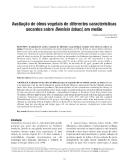Avaliaçao de óleos vegetais de diferentes características secantes sobre Bemisia tabaci, em melao
Alternative title
Evaluation of the effect of different types of vegetable oils on whitefly control, on melon Evaluación de aceites vegetales de diferentes características secantes sobre Bemisia tabaci, en melón
Description
2 tab. 8 ref.
Résumé
El melón es una de las hortalizas de mayor importancia en NE de Brasil. La mosca blanca (Bemisia tabaci) se ha convertido en una plaga que afecta su sistema de producción. La investigación tuvo como objetivo evaluar a la eficiencia de aceites vegetales del tipo no secante (ricino), semisecante (ajonjolí) y secante (soya) sobre B. tabaci en melón. El experimento se realizó en invernadero, en Embrapa Agroindustria Tropical, en Fortaleza-Ceará, Brasil. El diseño experimental fue de bloques al azar con seis tratamientos y cuatro repeticiones. Los tratamientos fueron: testigo, aceite a 0,25 por ciento, aceite a 0,50 por ciento, aceite a 1,00 por ciento, aceite a 2,00 por ciento y el producto comercial Thiamethoxam (Actara 250 WG)en las dosis de 0,2 gpc/l (gramos del producto comercial en el litro). El análisis de los resultados muestra que los aceites de ricino y ajonjolí fueron eficientes en el control de ninfas de mosca blanca el aceite de soya tuvo baja eficiencia el aceite del tipo no secante fue más eficiente que los semisecante y secante todos los aceites presentaron fitotoxicidad creciente, según aumentase su concentración. Melon is an important crop for the Northeastern region of Brazil. However, insect pests like the whitefly, Bemisia tabaci, have been a problem for producers. The main objective of this research was evaluating the efficacy of different types of oils, represented by castor bean, sesame seed and soybean oil, on melon whitefly. Field data for this research was collected at Embrapa -Agroindústria Tropical, at Fortaleza, Ceará State, Brazil, from November 2000 through February 2001. A completely randomized design was used, with four replicates and six treatments. Treatments were: untreated (control), oil at 0.25, 0.50, 1.00 and 2.00 percent, and the standard Thiamethoxam (Actara 250 WG) at 0.2 g.c.p./L. According to the results, castor bean and sesame oil were efficient in controlling whitely nymphs soybean oil showed low efficiency the non-drying oil was much more efficient than the semi-drying and drying types. All oils showed an increase of phytotoxic action when concentration was increased.
Keywords
Éditeur
Centro Agronómico Tropical de Investigación y Enseñanza (CATIE), Turrialba (Costa Rica)
Collections
- Publicaciones y documentos [4419]


